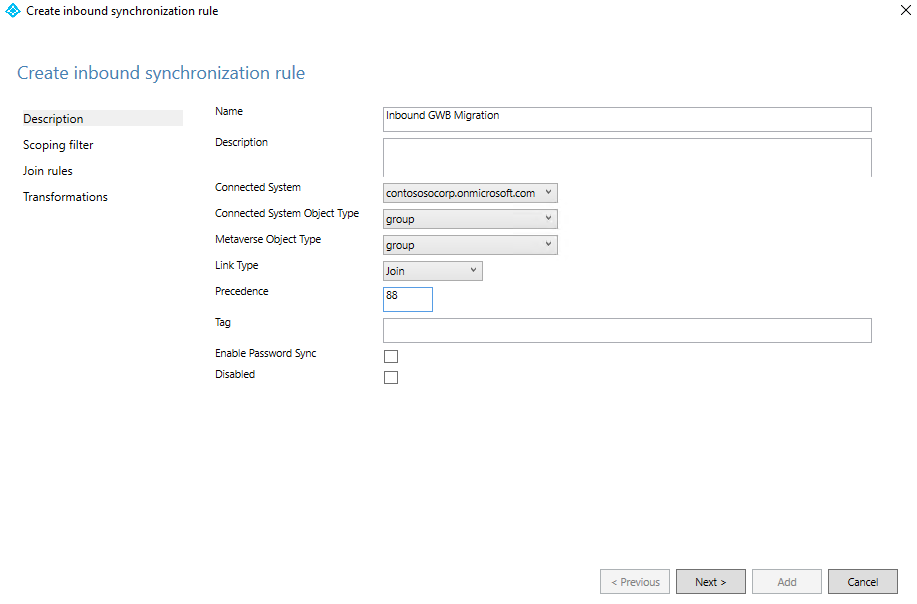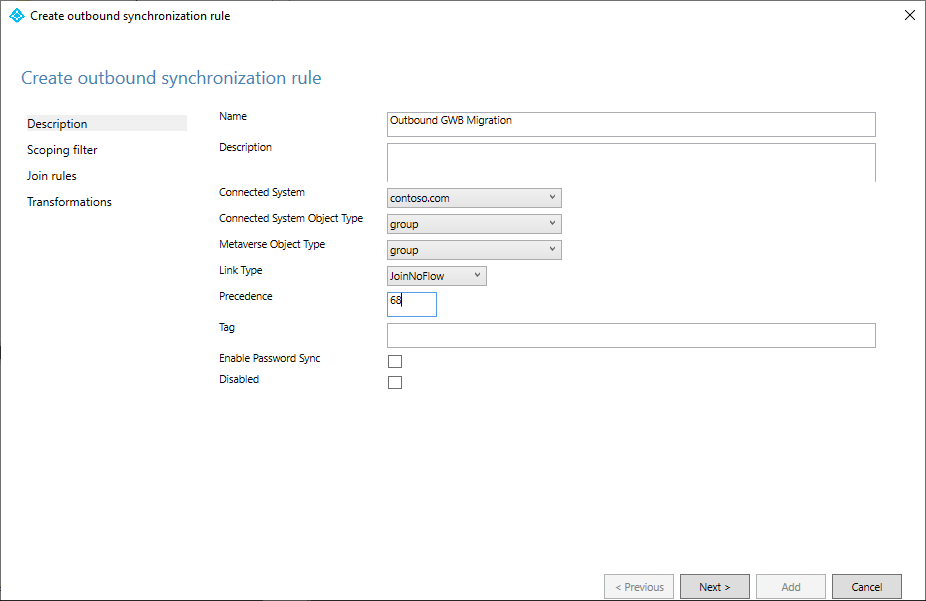Migrate Microsoft Entra Connect Sync group writeback V2 to Microsoft Entra Cloud Sync
Important
The public preview of Group Writeback v2 in Microsoft Entra Connect Sync will no longer be available after June 30, 2024. This feature will be discontinued on this date, and you will no longer be supported in Connect Sync to provision cloud security groups to Active Directory.
We offer similar functionality in Microsoft Entra Cloud Sync called Group Provision to Active Directory that you can use instead of Group Writeback v2 for provisioning cloud security groups to Active Directory. We're working on enhancing this functionality in Cloud Sync along with other new features that we're developing in Cloud Sync.
Customers who use this preview feature in Connect Sync should switch their configuration from Connect Sync to Cloud Sync. You can choose to move all your hybrid sync to Cloud Sync (if it supports your needs). You can also run Cloud Sync side by side and move only cloud security group provisioning to Active Directory onto Cloud Sync.
For customers who provision Microsoft 365 groups to Active Directory, you can keep using Group Writeback v1 for this capability.
You can evaluate moving exclusively to Cloud Sync by using the user synchronization wizard.
The following document describes how to migrate group writeback using Microsoft Entra Connect Sync (formerly Azure AD Connect) to Microsoft Entra Cloud Sync. This scenario is only for customers who are currently using Microsoft Entra Connect group writeback v2. The process outlined in this document pertains only to cloud-created security groups that are written back with a universal scope. Mail-enabled groups and DLs written back using Microsoft Entra Connect group writeback V1 or V2 aren't supported.
Important
This scenario is only for customers who are currently using Microsoft Entra Connect group writeback v2
Also, this scenario is only supported for:
- cloud created Security groups
- these groups are written back with the AD groups scope of universal.
Mail-enabled groups and DLs written back using Microsoft Entra Connect group writeback V1 or V2 aren't supported.
For more information, see the Provisioning to Active Directory with Microsoft Entra Cloud Sync FAQ.
Prerequisites
The following prerequisites are required to implement this scenario.
- Microsoft Entra account with at least a Hybrid Administrator role.
- An on-premises AD account with at least domain administrator permissions - required to access the adminDescription attribute and copy it to the msDS-ExternalDirectoryObjectId attribute
- On-premises Active Directory Domain Services environment with Windows Server 2016 operating system or later.
- Required for AD Schema attribute - msDS-ExternalDirectoryObjectId
- Provisioning agent with build version 1.1.1367.0 or later.
- The provisioning agent must be able to communicate with the domain controller(s) on ports TCP/389 (LDAP) and TCP/3268 (Global Catalog).
- Required for global catalog lookup to filter out invalid membership references
Step 1 - Copy adminDescription to msDS-ExternalDirectoryObjectID
In your on-premises environment, open ADSI Edit.
Copy the value that it in the group's adminDescription attribute
Paste in to the msDS-ExternalDirectoryObjectID attribute
Step 2 - Place the Microsoft Entra Connect Sync server in staging mode and disable the sync scheduler
Start the Microsoft Entra Connect Sync wizard
Click Configure
Select Configure staging mode and click Next
Enter Microsoft Entra credentials
Place a check in the Enable staging mode box and click Next
Click Configure
Click Exit
On your Microsoft Entra Connect server, open a PowerShell prompt as an administrator.
Disable the sync scheduler:
Set-ADSyncScheduler -SyncCycleEnabled $false
Step 3 - Create a custom group inbound rule
In the Microsoft Entra Connect Synchronization Rules editor, you need to create an inbound sync rule that filters out groups that have NULL for the mail attribute. The inbound sync rule is a join rule with a target attribute of cloudNoFlow. This rule tells Microsoft Entra Connect not to synchronize attributes for these groups.
Launch the synchronization editor from the application menu in desktop as shown below:
Select Inbound from the drop-down list for Direction and select Add new rule.
On the Description page, enter the following and select Next:
Name: Give the rule a meaningful name
Description: Add a meaningful description
Connected System: Choose the Microsoft Entra connector that you're writing the custom sync rule for
Connected System Object Type: Group
Metaverse Object Type: Group
Link Type: Join
Precedence: Provide a value that is unique in the system
Tag: Leave empty
On the Scoping filter page, Add the following and then select Next.
Attribute Operator Value cloudMastered EQUAL true mail ISNULL On the Join rules page, select Next.
On the Transformations page, add a Constant transformation: flow True to cloudNoFlow attribute. Select Add.
Step 4 - Create a custom group outbound rule
You'll also need an outbound sync rule with a link type of JoinNoFlow and the scoping filter that has the cloudNoFlow attribute set to True. This rule tells Microsoft Entra Connect not to synchronize attributes for these groups.
Select Outbound from the drop-down list for Direction and select Add rule.
On the Description page, enter the following and select Next:
- Name: Give the rule a meaningful name
- Description: Add a meaningful description
- Connected System: Choose the AD connector that you're writing the custom sync rule for
- Connected System Object Type: Group
- Metaverse Object Type: Group
- Link Type: JoinNoFlow
- Precedence: Provide a value that is unique in the system
- Tag: Leave empty
On the Scoping filter page, choose cloudNoFlow equal True. Then select Next.
On the Join rules page, select Next.
On the Transformations page, select Add.
Step 5 - Use PowerShell to finish configuration
On your Microsoft Entra Connect server, open a PowerShell prompt as an administrator.
Import the ADSync module:
Import-Module 'C:\Program Files\Microsoft Azure Active Directory Connect\Tools\ADSyncTools.psm1'Run a full sync cycle:
Start-ADSyncSyncCycle -PolicyType InitialDisable the group writeback feature for the tenant:
Set-ADSyncAADCompanyFeature -GroupWritebackV2 $falseRun a full sync cycle (yes again):
Start-ADSyncSyncCycle -PolicyType InitialRe-enable the sync scheduler:
Set-ADSyncScheduler -SyncCycleEnabled $true
Step 6 - Remove the Microsoft Entra Connect Sync server from staging mode
- Start the Microsoft Entra Connect Sync wizard
- Click Configure
- Select Configure staging mode and click Next
- Enter Microsoft Entra credentials
- Remove the check from the Enable staging mode box and click Next
- Click Configure
- Click Exit
Step 7 - Configure Microsoft Entra Cloud Sync
Now that you have successfully removed the groups from the scope of Microsoft Entra Connect Sync, you can set up and configure Microsoft Entra Cloud Sync to take over synchronization. See Provision groups to Active Directory using Microsoft Entra Cloud Sync.
Next Steps
Feedback
Coming soon: Throughout 2024 we will be phasing out GitHub Issues as the feedback mechanism for content and replacing it with a new feedback system. For more information see: https://aka.ms/ContentUserFeedback.
Submit and view feedback for









